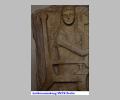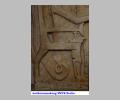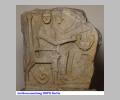| Collection: | Berlin, Antikenmuseen |
| Title: | Hero Relief from Chrysapha |
| Context: | From Chrysapha |
| Findspot: | Found at Chrysapha, near Sparta. The relief was found on the side of a hill south of Chrysapha, in an area known as Pikromygdalia. It was said to be standing upright, in a tumulus-like arrangement of earth and stone. Near it was a second stone undecorated but for the word |
| Summary: | Seated couple approached by worshippers |
| Object Function: | Votive |
| Material: | Marble |
| Sculpture Type: | Stele, relief-decorated |
| Category: | Single monument |
| Style: | High Archaic |
| Technique: | Low relief |
| Original or Copy: | Original |
| Date: | ca. 550 BC - ca. 540 BC |
| Dimensions: | H. 0.87 m, W. 0.65 m, Th. 0.10-0.13, Depth of relief 0.07 m. |
| Scale: | Under life-size |
| Region: | Laconia |
| Period: | High Archaic |
Subject Description:
The Chrysapha Relief, slightly less than a meter square, takes the form of a typical Laconian hero relief. A man and a woman sit enthroned. The man, long hair falling over his shoulders, is dressed in a chiton (indicated by vertical folds above the ankles; presumably painted on the neck and right arm) and himation worn under the right arm. On his feet are sandals. He holds a kantharos in front. The figure of the woman is largely obscured. Her dress is distinguished only by the folds which cover her legs. She wears a type of shoe popular in Ionia. Only the hair surrounding her forehead is treated sculpturally; the crown of the head was probably detailed in paint. In her right hand is a pomegranate. The throne is an elaborate piece of furniture: the legs resemble those of a lion, the tall back ends in a palmette and the arm is supported by a small column. A large snake, associated with death, rears up behind the throne. Standing on the footrest, facing the seated couple, are two figures miniature in scale by comparison with the two just described. Whether two women (Robertson) or a man and a woman (Blümel), they bear offerings of a cock, a blossom and eggs(?) clearly intended for the couple whom they honor.
The seated figures represent the heroized dead, honored by their relatives. That they do not represent deities was confirmed by the discovery of a similar relief inscribed with the name of Chilon, an historical figure from Sparta. On unmarked reliefs like the one from Chrysapha (a village outside Sparta), the names were probably inscribed in paint. The reliefs were erected over heroa or graves
Form & Style: The style is unsophisticated in many respects, including the general lack of modeling, the awkward rendering of perspective and the inconsistency of proportion and scale. Superficially the relief bears some similarity to the Sikyonian metopes at Delphi, particularly the Cattle metope. In both reliefs, depth is indicated by a succession of stepped planes. In the Chrysapha relief, however, there is virtually no modulation within each plane and the transition from plane to plane is an abrupt cut-back. Thus, while some sense of depth is achieved, the effect is far less persuasive than in the metope. A second point of similarity is the combined use of frontal and profile views. Like the cattle in the same metope, the head of the nearer figure is shown in a fully frontal position while his body, and the figure behind him, is represented in profile. In apparent confusion, the upper torso is represented in a combination of those views which makes no sense at all. The impression is that these are sculptural tricks seen elsewhere and copied without a thorough understanding of what lay behind them. Although the Sikyonian metopes are usually dated in the second quarter of the 6th century, this relief can be later. Blümel puts it in the third quarter of the century and sees, in the diagonal folds of the garments among other things, Ionian influence
Condition: Intact
Condition Description: Small fragment missing from upper right corner; otherwise complete. Surface in good condition, with some weathering.
Material Description: Gray-blue marble
Collection History: The relief was purchased from a local farmer, becoming part of the Sabouroff Collection, from which it was acquired for the Museum.
Sources Used:





